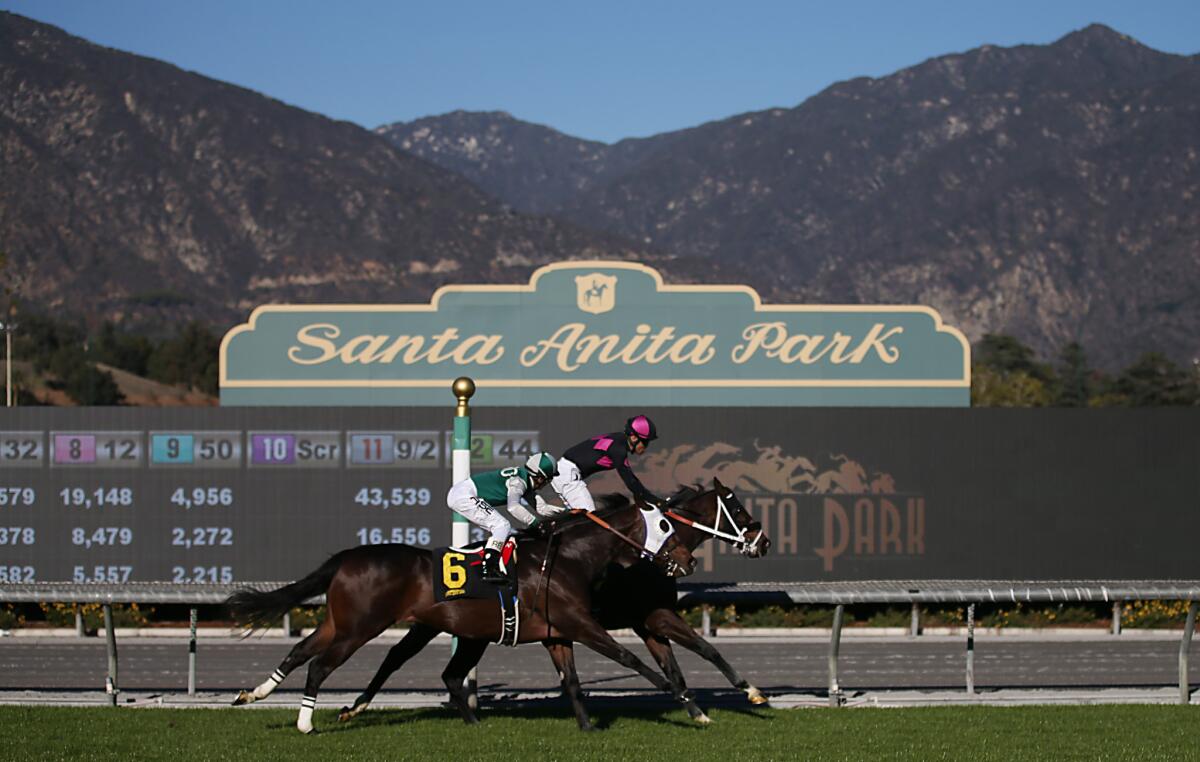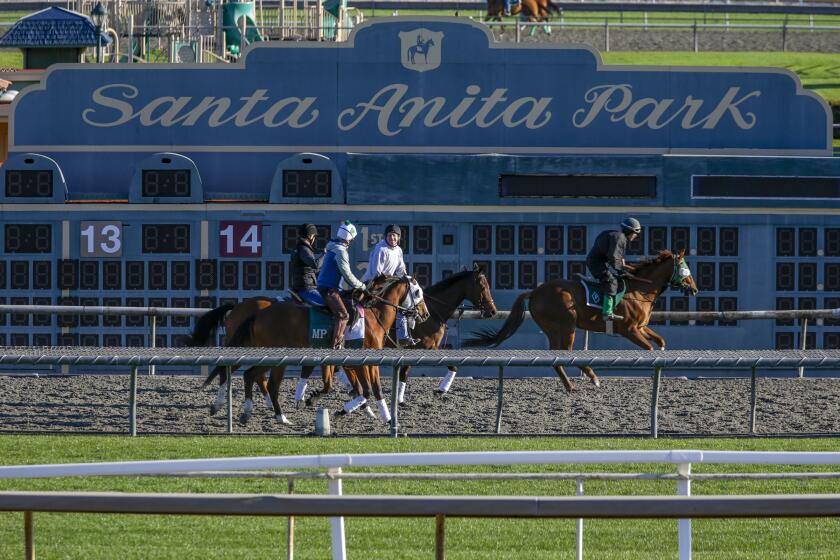Questions and answers with new Santa Anita’s new racing boss, Aidan Butler

- Share via
Aidan Butler, 42, is the new acting executive director of California racing for the Stronach Group, which owns and operates Santa Anita Park. The thoroughbred race track is set to open its fall meeting on Friday, a schedule which will conclude with the Breeders’ Cup, Nov. 1-2.
During this year’s winter-spring meeting at the Arcadia track, 30 horses died during racing and training, and there were calls to shut down. Recently, Butler met with the Los Angeles Times to talk about his vision for Santa Anita and the challenges ahead. His answers were edited for clarity and length.
You’ve never run a race track. So, why are you the right choice for this job?
Obviously, there are varied degrees of the title of running a race track. Am I going to check the track surface? No, that’s the head of track team, veterinarians the same, outriders the same. I’m here to do a couple of things. A) Keeping up the momentum of safety is absolutely paramount. I’m going to be making sure there is no dozing off along the chain. B) Horse racing is at such a pivotal time. People are wondering if it’s going to last. What’s the future? What does the public deserve? What do the horsemen deserve? A lot is rooted in 1934 — that’s the way horse racing has always been. I could argue it’s an ideal time for a person like me because I know what’s at stake. I understand the innovations needed for us to grow.
Is the horse racing business model broken?
I don’t know if it’s necessarily broken. Lots of horse racing with lots of full fields is the best anyone could hope for. How you get there is the question. First, you need the right horse population and a safety and medication package around it. Now you have lots of healthy horses that are good to run. How often you can run is where the business model will be proven. … The business model is second fiddle to the safety of running it right. If we’re ever going to be the Sport of Kings again, it’s going to be based on regaining public trust.
What safety protocols do you have that are different from Del Mar?
From a medication standpoint, they are all the same. Del Mar took our system and, some would say, improved on it, made it a little bit more user friendly, subtracted and added where they thought it was necessary. We are going to version 2.0 of the Del Mar protocol, where we mirror theirs more than they mirrored the previous Santa Anita ones.
The racing office was in trouble last meeting. How is it going to be fixed?
We’ve got a lot of different eyeballs on the condition book this year. (This refers to the schedule of races for a track during a period of time. It provides a framework for trainers to develop plans for their horses.) I reached out to Del Mar and Tom Robbins [executive vice president of racing and industry relations] and David Jerkens [racing secretary] collaborated with [Santa Anita racing secretary] Steve Lym on it. A collaborative California condition book makes sense. It’s the same horses, it’s the same trainers.
How do you get back the horses that left Santa Anita and went elsewhere?
We struggled with purses and people are a little wary of Santa Anita, but the Great Race Place has something no one else has and that’s we’re the Great Race Place. It’s an environment that is absolutely beautiful, living here, working here, you can’t recreate it. We don’t have a horse shortage, we have an owner shortage. I’m going to try to bring the Great Race Place back with a lot of the pageantry. It’s what happens when people look at the old stuff and get excited. You’ve got to bring some of that back. And you’ve got to bring the entertainment back; to get the horses back you’ve got to make it such a cool place that people want to be here. There has got to be more to the game than just simulcasting.
Zeke, a 4-year-old gelding trained by Dean Pederson, sustained a pelvic fracture during a training session Monday at Santa Anita and was later euthanized.
I don’t recall Santa Anita taking the blame for anything. Should the track get some of the blame?
Could things have been handled better across the board? Yes. There were mistakes made. Am I going to blame anyone? No. But could we have done a better job? Yeah. It was a perfect storm.
How will you handle the 12 days you are required to cancel racing?
There is no doubt we need some breaks. We don’t know what the weather is going to be. It would be ideal to say this week and that week in advance, but you don’t know the weather. The smart approach is to call them on the fly, and I’m asking for a bunch of trust because I’m going to be the one saying yay or nay.
Does racing on the downhill course return on Dec. 26?
Currently, there is no answer on that. If it’s safe, it’s a spectacular race. But spectacle does not override safety. When it comes to safety, you’ve got to be collaborative. Everybody needs a voice. Is everybody comfortable with it? No. That’s where we stand at the moment.
Your predecessor, Tim Ritvo, talked about flipping the dirt and turf course. Is that in the plans?
If you look at the downhill course and think it’s not going to be utilized, you look to reprogramming the whole track. You look to see if there are any other chutes you can have; any other races you can program. And then there is big conversation. If we can get the public confidence back, and we feel proud of what we do, Santa Anita is the kind of place that might warrant a full redesign. If you can have the downhill stay on grass the whole way, it eliminates the conversation on the crossover.
More to Read
Go beyond the scoreboard
Get the latest on L.A.'s teams in the daily Sports Report newsletter.
You may occasionally receive promotional content from the Los Angeles Times.












